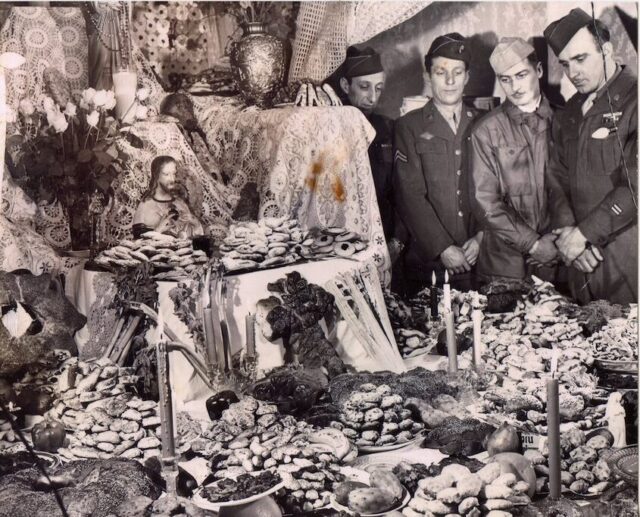
La Signora Vincenza Tomasello and her five daughters were busy shopping, baking and preparing their home for visitors on a very special day, a truly glorious day.
The women were thrilled because it was March 19 — St. Joseph’s Day — but it was so much more than that. The year was 1946, World War II had finally ended and their men were home at last.
The Tomasello women were preparing for their annual St. Joseph’s Table, and every detail had to be perfect. Three tiers tall and topped with a statue of San Giuseppe, the table would be laden with meatless dishes, sweets and bread in various symbolic shapes.
These tables were common throughout Chicago’s Little Sicily, where the family lived. It was a tradition brought over by immigrants from the island, where San Giuseppe is the patron saint. The act of devotion began centuries before, in gratitude to St. Joseph for favors granted.
With the war over and much of the military stateside, all of America had much to be grateful for. Two of those returning soldiers were sergeants Joseph Tomasello and Roy Decker.
Born to Vincenza and Leonardo Tomasello, who emigrated from Sicily, Joe was proud to serve the country that took his parents in. The Army sent Joe to Asia, where he was injured and evacuated to the medical center in Hawaii. The government flew La Signora Tomasello to her son’s bedside for a tear-filled reunion.
Upon his recovery, Joseph was assigned to the Military Police in the states, where he was tasked with transporting prisoners of war to detention camps. While escorting three Italian POWs, Joseph stopped by the family home on Orchard Street, where his mother prepared lunch for them all. According to family legend, La Signora Tomasello took Joseph aside and said, “These are good boys, Joe, let them go,” and he did what his mother told him.
Born in Chicago in 1918 to Roy Sr. and Cristina Ulrich Decker, Roy grew up in the Lincoln Park neighborhood. After high school, he became a teamster, and before entering the U. S. Army in 1942 at the age of 24, he married Joe’s sister, Catarina.
Assigned to Patton’s Third Army, Roy and his platoon came ashore at Utah Beach and famously outran their maps while liberating hundreds of French villages. He fought in the battles of the Bulge and the Ardennes Forest and led his squad in the attack on the Siegfried Line. They won that vicious fray and were some of the first to enter Germany.
Joseph and Roy, along with two of their Army buddies, were among the many guests who converged on Casa Tomasello to partake of the family’s extravagant spread. A photographer from the Chicago Sun Newspaper captured the moment with the incredible photo showcased here.
Early on the morning of St. Joseph’s Day, a priest came to bless the home and the food on the table. The event was an open house, with many guests leaving donations to offset expenses and all departing with a box of cookies and a loaf of St. Joseph’s bread to take home.
Life took my uncle Joe and my father, Roy, in very different directions in the coming years.
Tragically, Joe was struck and killed by a hit-and-run driver on Lake Shore Drive while riding his motorcycle to work in 1948. He was buried with full military honors, and his mother kept a candle burning for her cherished son until her death many years later.
Roy worked as a truck driver, passing away at the age of 77 in the VA Hospital in Waukegan. He was the father of three and had five grandchildren and four great-grandchildren at the time of his passing.
But for one blessed moment on March 19, 1946, they stood together in the loving embrace of their family at a glorious St. Joseph’s Table and gave thanks that they were home.

 Fra Noi Embrace Your Inner Italian
Fra Noi Embrace Your Inner Italian






